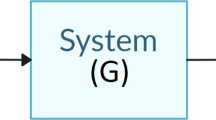Abstract
In the research field of model predictive control (MPC), an output-feedback-type MPC method is consistently required for controlling a wide range of constrained systems. In this paper, we propose a two-stage control strategy for polytopic linear parameter varying (LPV) systems subject to input constraints. This strategy consists of a modified quasi-min-max output-feedback MPC method and a novel terminal output-feedback robust control technique. The proposed control mechanism involves the system states to be first controlled via the MPC method to be driven into a prescribed neighborhood of the origin, and then, the terminal output-feedback robust control method guaranteeing the input constraints is applied to make such states converge to the origin. It is also verified that our control method guarantees the closed-loop stability and feasibility in the presence of model uncertainties and input constraints. Finally, a numerical example is given to demonstrate its effectiveness.
Similar content being viewed by others
References
D. Q. Mayne, J. B. Rawlings, C. V. Rao, and P. O. M. Scokaert, “Constrained model predictive control: stability and optimality,” Automatica, vol. 36, no. 6, pp. 789–814, 2000. [click]
S. Bououden, M. Chadli, L. Zhang, and T. Yang, “Constrained model predictive control for time-varying delay systems: application to an active car suspension,” Inter national Journal of Control, Automation, and Systems, vol. 14, no. 1, pp. 51–58, 2016.
P. Bagheri and A. Khaki-Sedigh, “Closed form tuning equations for model predictive control of first-order plus fractional dead time models,” International Journal of Control, Automation, and Systems, vol. 13, no. 1, pp. 73–80, 2015. [click]
M. A. Mohammadkhani, F. Bayat, and A. A. Jalali, “Design of explicit model predictive control for constrained linear systems with disturbances,” International Journal of Control, Automation, and Systems, vol. 12, no. 2, pp. 294–301, 2014. [click]
A. Casavola, M. Giannelli, and E. Mosca, “Min-max predictive control strategies for input-saturated polytopic uncertain systems,” Automatica, vol. 36, no. 1, pp. 125–133, 2000. [click]
F. A. Cuzzola, J. C. Geromel, and M. Morari, “An improved approach for constrained robust model predictive control,” Automatica, vol. 38, no. 7, pp. 1183–1189, 2002. [click]
M. V. Kothare, V. Balakrishnan, and M. Morari, “Robust constrained model predictive control using linear matrix inequalities,” Automatica, vol. 32, no. 10, pp. 1361–1379, 1996. [click]
J. H. Lee and Z. Yu, “Worst-case formulation of model predictive control for systems with bounded parameters,” Automatica, vol. 33, no. 5, pp. 763–781, 1997. [click]
Y. Lu and Y. Arkun, “Quasi-min-max MPC algorithm for LPV systems,” Automatica, vol. 36, no. 4, pp. 527–540, 2000. [click]
Z. Wan and M. V. Kothare, “Robust output feedback model predictive control using off-line linear matrix inequalities,” Journal of Process Control, vol. 12, no. 7, pp. 763–774, 2002. [click]
J.-H. Park, T.-H. Kim and T. Sugie, “Output feedback model predictive control for LPV systems based on quasimin-max algorithm,” Automatica, vol. 47, no. 9, pp. 2052–2058, 2011. [click]
Y. Su and K. K. Tan, “Comments on ‘Output feedback model predictive control for LPV systems based on quasimin-max algorithm’,” Automatica, vol. 48, no. 9, pp. 2385, 2012. [click]
S. P. Boyd, L. El Ghaoui, E. Feron and V. Balakrishnan, Linear Matrix Inequalities in Systems and Control Theory, SIAM, 1994.
R. Smith, Model Predictive Control of Uncertain Constrained Linear Systems: LMI-based Methods, University of Cambridge, 2006.
Z. Wan and M. V. Kothare, “An efficient off-line formulation of robust model predictive control using linear matrix inequalities,” Automatica, vol. 39, no. 5, pp. 837–846, 2003. [click]
Author information
Authors and Affiliations
Corresponding author
Additional information
Recommended by Associate Editor Do Wan Kim under the direction of Editor Myo Taeg Lim. This work was supported by the Human Resources Program in Energy Technology of the Korea Institute of Energy Technology Evaluation and Planning(KETEP) granted financial resource from the Ministry of Trade, Industry & Energy, Republic of Korea (No.20134030200350 ), and was also supported by the Chung-Ang University Excellent Student Scholarship in 2015.
Tae-Hyoung Kim received the B.S. and M.S. degrees in mechanical engineering from Chung-Ang University, Korea, in 1999 and 2001, respectively. He received the Ph.D. degree in informatics from Kyoto University, Japan, in 2006. From April 2006 to February 2007, he was a guest research associate in the Department of Systems Science, Kyoto University. From March 2007 to August 2008, he was a researcher in the Japan Science and Technology Agency (JST). He is currently an Associate Professor at the School of Mechanical Engineering, Chung- Ang University. His current research interests include robust control, multi-agent system, particle swarm optimization, system identification, model predictive control, iterative learning control and systems biology.
Ho-Woon Lee received the B.S. and M.S. degrees in mechanical engineering from Chung-Ang University, Korea, in 2014 and 2016, respectively. His current research interests include parallel robot systems, system identification, meta-heuristic optimization and robust control algorithm.
Rights and permissions
About this article
Cite this article
Kim, TH., Lee, HW. Quasi-min-max output-feedback model predictive control for LPV systems with input saturation. Int. J. Control Autom. Syst. 15, 1069–1076 (2017). https://doi.org/10.1007/s12555-016-0378-y
Received:
Revised:
Accepted:
Published:
Issue Date:
DOI: https://doi.org/10.1007/s12555-016-0378-y




